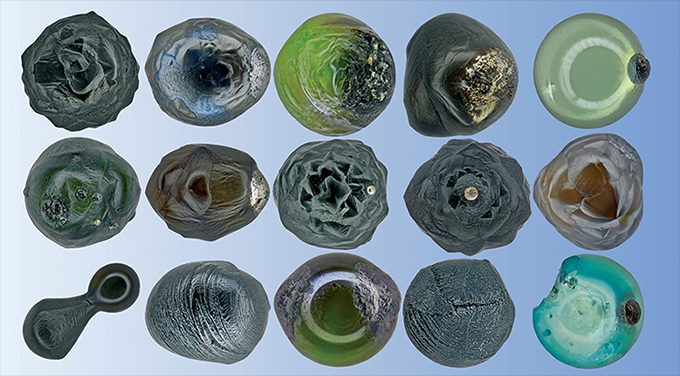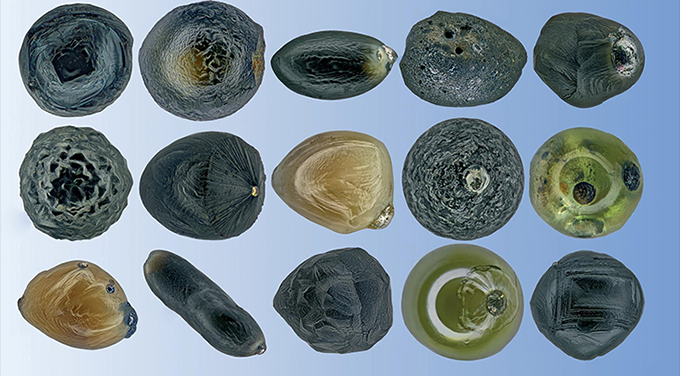On the lookout for micro-missiles from space
These smallest of “shooting stars” can damage satellites — or deliver big benefits for science
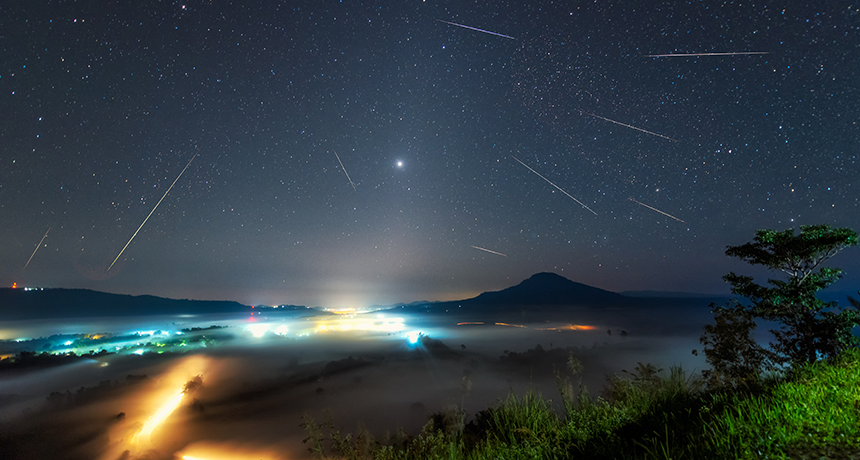
Space dust rains down on Earth all the time. Most of these specks are too small to see. But when one the size of a sand grain hits the atmosphere, it blazes with visible light, becoming a micrometeor, or “shooting star.”
x-reflexnaja/istockphoto
Every second, billions of teeny-tiny missiles strike Earth. They come from outer space. But it’s not an alien attack. These speeding objects are actually bits of space dust. They come in all sizes. Some contain only a few molecules. Others are similar in size to the specks under your bed that glom together into dust bunnies. And the biggies? They can be the size of sand grains.
Some of these specks formed when asteroids slammed into planets, moons or other space rocks. Others are debris left behind by comets streaking around the sun. And a few have traveled in from way outside our solar system. What all of these motes have in common is speed. They fly at up to 72 kilometers per second (45 miles per second). That’s 50 times faster than a speeding bullet!
Such super-speedy dust grains can damage equipment orbiting in space. In fact, they can punch right through metal or glass. So why don’t these falling microrocks harm our roofs or roads — or even our bodies? Thank a gigantic shield that protects our planet. The air all around us may seem like nothing. To a dust grain zooming through the near-emptiness of space, however, that air might as well be a solid wall.
After smacking into the atmosphere, space dust slows down. Some bits vaporize, giving off a lot of heat and light. Specks the size of a grain of sand or larger can shine brightly enough to see. These are known as meteors, or shooting stars. (Larger space rocks can become shooting stars, too.) Some space dust vaporizes completely. But other specks melt, solidify again and then fall gently to the ground. There, they tend to mingle with all of the other dust from various sources.
Throughout the journey of a speck of space dust, scientists are watching and learning. Researchers study how space dust damages satellites. They work out what happens when bits of dust collide with particles in Earth’s atmosphere. And on the ground, they’re sifting through gutters in search of micrometeorites — bits of space dust that have survived the long journey to Earth.
“Insanely fast”
One moment, the satellite Copernicus Sentinel 1A was minding its own business, taking pictures of Earth’s surface. The next, something smacked into one of the solar panels that provide power to the craft. The impact made a dent wider than a basketball. The culprit was a speck of space dust about as big as a grain of sand. Luckily, the damage wasn’t too bad. Lots of the satellite’s other solar panels still work.
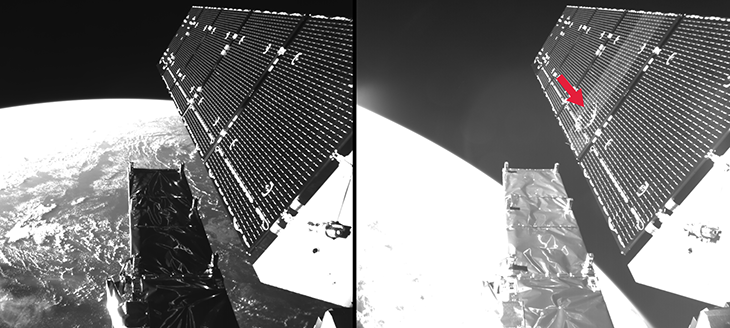
How does something as tiny as a sand grain make such a large dent? The key is speed. “These things are going insanely fast,” says Sigrid Close. She is an engineer who studies spacecraft design at Stanford University in Palo Alto, Calif. That high speed gives larger grains enough power to puncture a spacecraft.
But large grains are fairly rare. Most space dust particles are microscopic. The dents or tiny holes they make are nothing to worry about. They might cause another type of damage, though. Sometimes, electrical systems on spacecraft fail and no one can figure out why. Close thinks teeny specks of dust might be to blame for some of these failures.
When a speck slams into a spacecraft, it explodes. The explosion “looks like a tiny little nuclear detonation,” says Close. If the impact happens at a high enough speed, it creates a burst of radiation, known as an electromagnetic pulse (EMP). It will send a jolt of electricity through any nearby electronics. This may cause a glitch or shut them down.
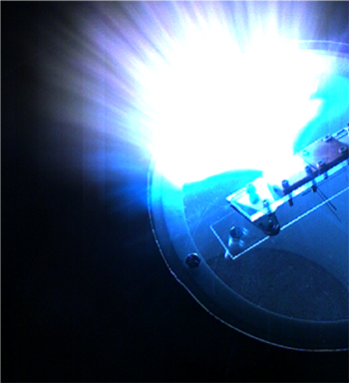
In experiments on Earth, Close pelted spacecraft materials with fast-moving particles. Then she measured the explosions. The EMPs were strong enough to mess up electronics, she confirmed.
These EMPs likely would not affect any equipment deep inside a spacecraft or station. But they could mess with electronics on the outside of a spacecraft, such as the antennae that transmit data. If an astronaut were out on a spacewalk and a dust speck hit the spacecraft nearby, an EMP could potentially knock out communications, says Close. Her work aims to help engineers figure out better ways to shield electrical equipment from these micro-impacts.
Dust to dust
Earthbound specks that don’t slam into satellites or other objects will have to survive a new obstacle: air. The atmosphere is made of gas molecules and bits of floating Earth dust. That air thins the higher you rise.
In the very upper reaches, 150 kilometers (more than 93 miles) off the ground, an interesting thing can happen. Space dust can “[scrape] off bits of the atmosphere,” explains Arjun Berera. He is a theoretical physicist at the University of Edinburgh in Scotland. Specks of space dust can send Earth’s native dust careening off into space.
It’s like what happens when one ball strikes another during a game of mini golf. The first ball stops or slows down as the smacked one speeds away. In the upper atmosphere, speeding space dust gives drifting gas molecules or dust specks a huge kick. They can get moving fast enough to escape the pull of Earth’s gravity, Berera’s calculations show. And in the thin air, this gives them a good chance of flying off into outer space without crashing into anything else on the way.
Such particles may now end up traveling to other planets. If they are moving fast enough, they might even sail on to other solar systems. That means Earth might be able to exchange parts of its sky with those of other worlds.
Could the planets exchange more than just gas and dust? Could microscopic life forms get caught up in the action? Berera thinks it’s possible. So space dust, he says, might help spread Earth’s life through the universe. It’s not a given, he adds — but a big “maybe.” And here’s why.
A microbe would have to be floating very high in the air for a space speck to kick it out of the atmosphere. Microscopic life forms do live in the sky. But people have only found them up to about 15 kilometers (9 miles) above Earth’s surface. That’s just a tenth the altitude they’d need to get catapulted into space by a space-dust encounter.
It’s possible that microscopic life exists at this height. To date, however, no one has seen that. In the far reaches of the upper atmosphere, everything is spread out very thinly. Finding any life up there “would be like looking for a needle in a pack of hay,” says Kostas Konstantinidis. At the Georgia Institute of Technology in Atlanta, he studies the life forms in Earth’s atmosphere.
He was not involved in Berera’s research. He does, however, think it makes sense that some life forms would make it to the upper atmosphere. They would just be very rare.
If high-flying microbes exist, they’d have to survive a rapid collision with a speck of space dust. Then they’d need to hunker down for a long journey through outer space. Finally, they would have to land somewhere with water and other necessities for staying alive.
This all seems highly unlikely. But some microscopic life is incredibly tough. Certain microbes can shut down their metabolism. That means they basically turn off their bodies. They can spend thousands of years in that suspended animation. Only when conditions improved would they can start growing again, he says.
The thought that space dust might send microscopic life rocketing between the planets is “a good, crazy idea,” Konstantinidis says. It will take many more experiments, however, to confirm whether this could happen.
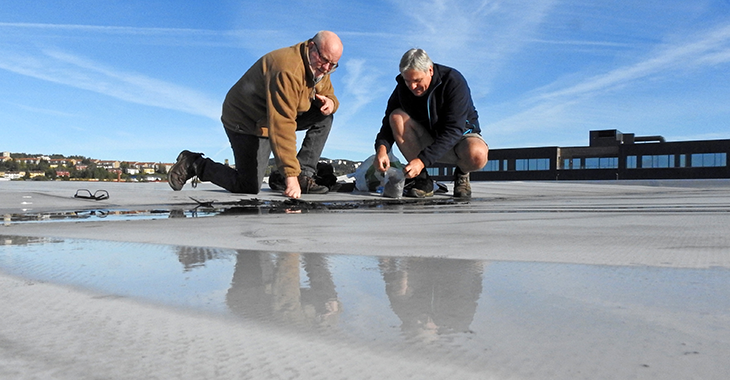
Finding treasure in the gutters
Jon Larsen knows crazy ideas. He is a jazz musician in Oslo, Norway, who has always enjoyed rock hunting. One June morning in 2009, he was eating breakfast outside at his vacation cottage. “Suddenly this small dot appeared on my table,” he says. “I put it on my fingertip.” It was a very tiny, round rock. It seemed to have fallen straight out of the sky.
Larsen’s rock hunting suddenly took a crazy turn. He decided to search for micrometeorites — space dust that has made it all the way to the ground. He learned that such micro-rocks fall to Earth all the time. But no one thought it was possible to find them in cities. Most micrometeorites are black, shiny stones, spherical in shape. Dust from power drills, engines, factories and other human activities can look similar.
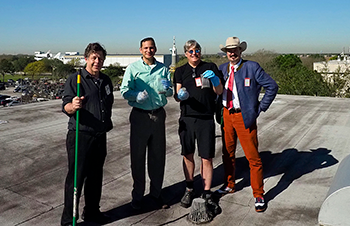
But Larsen didn’t let this fact stop him. He began collecting dust from roadsides and scooping it from rooftops. “It’s a very dirty job,” he says. He looked at the dust under a microscope and began sorting it. He learned the difference between specks of pavement and grains from fireworks. He looked at dust from a welding shop and a steam locomotive. He learned to recognize dust that definitely wasn’t from space.
A breakthrough came in 2015. That’s when he found his first micrometeorite. He was at his cottage again. “I found one in the rain gutter,” he says. Matthew Genge, a meteorite expert in England at Imperial College London looked at a picture of his prized speck. It looked promising, so he invited Larsen to his lab. There, Genge ran that grain and several dozen others through tests. At the end, he concluded that Larsen had found 50 micrometeorites.
Now, Larson has become a guest researcher at the University of Oslo. He’s found thousands of micrometeorites and written two books about the process. Anyone can do it, he says.
The first step is to gather dust. Rooftops are the best place to look, Larsen says. He rinses the dust and then uses a screen to filter out particles more than 300 micrometers wide — roughly four times the width of a human hair. Then he dries the dust, puts a plastic bag over a magnet and passes the magnet over the dust. Most micrometeorites are magnetic. So he carefully pulls the bag off the magnet to collect any dust that has stuck. These grains are what he looks at under a microscope.
Even after all these steps, Larsen might look at 10,000 grains to find just one from space. “They are rare, lonely, small rocks,” he says. “But they are everywhere. You will find them on absolutely every roof.”
Larsen takes beautiful photographs of the micrometeorites he finds. He’s even displayed their images in an art gallery. But his work has had an impact on science, too. Researchers study micrometeorites to learn about the solar system. Each speck is like a time capsule from a long-ago collision or other cosmic event. Larsen has made it easier than ever to locate these rare bits of space dust. In his spare time between gigs as a jazz artist, “He ended up making a discovery that professional scientists missed,” Genge says.
Grains of space dust may be small, but they can have a huge impact. Sometimes it’s a headlong crash into a satellite or a particle careening through Earth’s atmosphere. At other times, its impact can be seen on science itself. When people find these minuscule missiles from space, they can give science a glimpse into the history of our solar system and the universe beyond.


